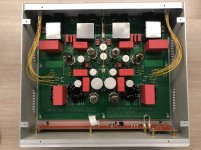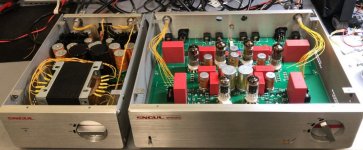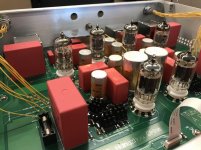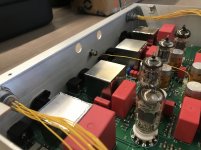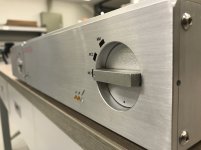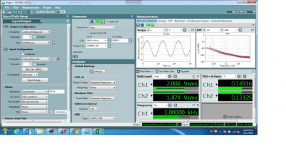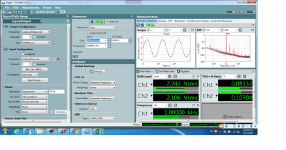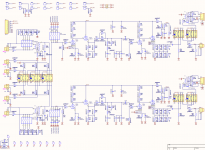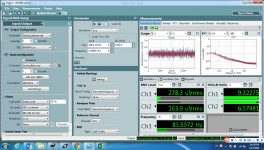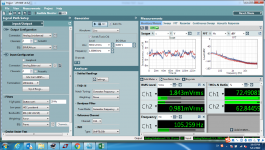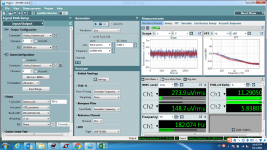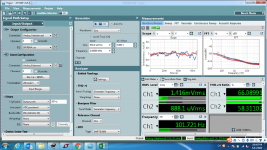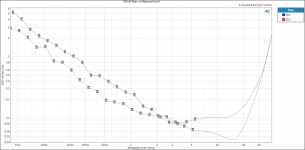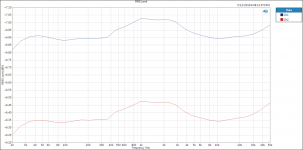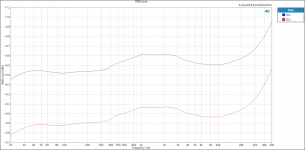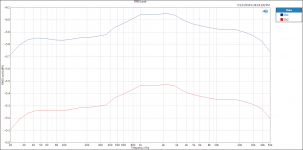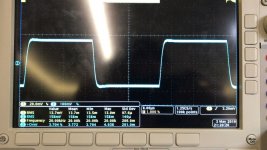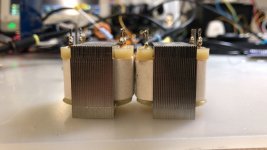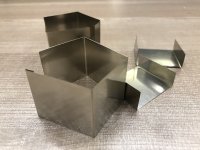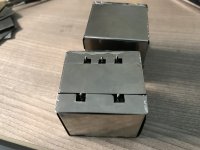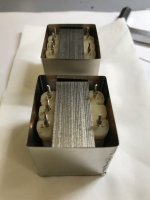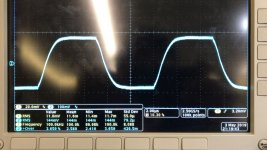Passively Equalized RIAA Tube Phono Preamp Based on ECC83 ECC82 & Fake NAGRA Chassis
Almost one year working on this project, finally it comes out.
Fully tube amplification design based on ECC83 and ECC82 (follower), 2 gain stage, passively RC RIAA equalization, MM/MC input with step up trans, direct output from capacitor coupled RCA, balanced output through trans.
Separated power supply unit, connect to main unit via LEMO connectors, because I try to pretend to have a poor man's NAGRA
Fully hand wind MC step up transformer 1:11 , balanced output transformer 1:0.5+0.5, hand made magnetic shield case... that transformers cost a lot of time and patient.
MM Gain 52dB
MC1 Gain 72dB (with step up transformer)
MC2 Gain 52dB (for external step up transformer use, like 1:40 ratio etc.)
Yet it would be far away from NAGRA's electrical specification and sound standard, but I am quite satisfy with this phono preamp now
* All contents on this post are not for commercial use.
Almost one year working on this project, finally it comes out.
Fully tube amplification design based on ECC83 and ECC82 (follower), 2 gain stage, passively RC RIAA equalization, MM/MC input with step up trans, direct output from capacitor coupled RCA, balanced output through trans.
Separated power supply unit, connect to main unit via LEMO connectors, because I try to pretend to have a poor man's NAGRA
Fully hand wind MC step up transformer 1:11 , balanced output transformer 1:0.5+0.5, hand made magnetic shield case... that transformers cost a lot of time and patient.
MM Gain 52dB
MC1 Gain 72dB (with step up transformer)
MC2 Gain 52dB (for external step up transformer use, like 1:40 ratio etc.)
Yet it would be far away from NAGRA's electrical specification and sound standard, but I am quite satisfy with this phono preamp now
* All contents on this post are not for commercial use.
Attachments
Last edited:
SCH
1st gain stage+follower provides ~36dB voltage gain, a passively RIAA equalization cuts 20dB off, 2nd gain stage+follower provides another 36dB voltage gain, so, for MM input there's ~52dB gain. Here a pair of TFK ECC83 and a pair of MULLARD M8136/CV4003 are used.
It seems that hardly no commerical Phono Preamp on the market features in non-loop feedback design. Because matching tubes are too difficult? or too expensive?
I made the four transfomers by myself. Because I found no commercial transformers can match my requirement, unless special order??
Most of the resistors are VISHAY MMB0207, they are pretty good looking and very reliable (AECQ for automotive).
1st gain stage+follower provides ~36dB voltage gain, a passively RIAA equalization cuts 20dB off, 2nd gain stage+follower provides another 36dB voltage gain, so, for MM input there's ~52dB gain. Here a pair of TFK ECC83 and a pair of MULLARD M8136/CV4003 are used.
It seems that hardly no commerical Phono Preamp on the market features in non-loop feedback design. Because matching tubes are too difficult? or too expensive?
I made the four transfomers by myself. Because I found no commercial transformers can match my requirement, unless special order??
Most of the resistors are VISHAY MMB0207, they are pretty good looking and very reliable (AECQ for automotive).
Attachments
It seems that hardly no commerical Phono Preamp on the market features in
non-loop feedback design. Because matching tubes are too difficult? or too expensive?
This one is from 1959.
https://www.quadesl.com/schematics/hkcit1_sch.gif
Also see page 702 here.
http://www.tubebooks.org/tubedata/RC30.pdf
Last edited:
It seems that hardly no commerical Phono Preamp on the market features in non-loop feedback design.
Perhaps 30 years ago this was true. Today there are dozens if not hundreds of nfb-free phono stages on the market. In fact the majority of high-end valve phono stages use passive correction and no global nfb.
Perhaps 30 years ago this was true. Today there are dozens if not hundreds of nfb-free phono stages on the market. In fact the majority of high-end valve phono stages use passive correction and no global nfb.
Perhaps I am too young & too naive

The only website I can search is stereophile equipment reviews, from where I can know the equipment design, sound style, measurement result, etc..
So, please give an example for non-loop feedback design based on passively RIAA equalization, especially use ECC83/12AX7 as amplification tube.
Klimo Merlin, they may use passively RIAA with ECC88/ECC808? No 3rd party measurement can be found.
Ypsilon VPS-100? Ultra-expensive one, C3g tube, but no measurement result.
Just for this DIY project, I made the measurement on noise, both non-weighting and A-weighting result, 10Hz to 90kHz bandwidth. Input shorted, but ground connect to Audio Precision APX-525, just like a real vinyl system ground loop.
Gain MM=52.5dB
MM L/R 1.4mV/888uV ~ 63.6dB/67.6dB SNR @ 5mV REF. input voltage
MM L/R 270uV/150uV ~ 78dB/83dB SNR @ 5mV REF, A-weighted
Gain MC=72dB
MM L/R 1.8mV/981uV ~ 60.9dB/66.2dB SNR @ 500uV REF. input voltage
MM L/R 280uV/160uV ~ 77dB/81.9dB SNR @ 500uV REF, A-weighted
Attachments
Last edited:
THD+N vs. Vout
10K load, 10Hz to 90kHz bandwidth, no weighting.
When AP source is in the signal loop, noise performance degrades due to residual noise of AP signal source.
ref. to 500uV MC input signal, the output is 2V, ~0.1% THD+N.\
Minimum THD+N ~0.05%, strongly related to the ECC83 tubes.
Maximum output close to 40Vrms @ 1% THD.
In this project, a pair of TELEFUNKEN ECC83 are used for amplification.
SIEMENS ECC83 (made by EI) provides best noise performance ~600uV to 800uV, and ultra-high gain 54dB.
MULLARD ECC83 short plate, 1mV to 3mV, tested on 3 samples.
Next step MULLARD M8137 or TESLA E83CC?
10K load, 10Hz to 90kHz bandwidth, no weighting.
When AP source is in the signal loop, noise performance degrades due to residual noise of AP signal source.
ref. to 500uV MC input signal, the output is 2V, ~0.1% THD+N.\
Minimum THD+N ~0.05%, strongly related to the ECC83 tubes.
Maximum output close to 40Vrms @ 1% THD.
In this project, a pair of TELEFUNKEN ECC83 are used for amplification.
SIEMENS ECC83 (made by EI) provides best noise performance ~600uV to 800uV, and ultra-high gain 54dB.
MULLARD ECC83 short plate, 1mV to 3mV, tested on 3 samples.
Next step MULLARD M8137 or TESLA E83CC?
Attachments
Good job!
Keep the measurements coming.
Thanks.
RIAA error
MM/MC with 10R&20R signal source resistance
Attachments
So, please give an example for non-loop feedback design based on passively RIAA equalization, especially use ECC83/12AX7 as amplification tube.
There is nothing remarkable about ECC83 other than availability. Personally not a fan of the sound and even objectively it is not such a great valve. As for examples, these come to mind starting with the letter A. Some indeed use ECC83s.
6moons audio reviews: Acousticbuoy Scorpio
Aesthetix : Products : Saturn Series : Rhea Phono Stage
Allnic Audio H-1202 Phono Stage — Audiophilia
Audionote
Talos Mk2 Reference phono system - Aries Cerat
6moons audio reviews: Art Audio Vinyl Reference
Audio Tekne
https://www.audiovalve.info/shop/pre-amplifiers/sunilda/
https://www.ayonaudio.com/products/preamplifier/phonostage/spheris/
The schematic in post 2 is quite similar to my phono built 25 years ago. I always use this topology for different reason. First af all the use of a low Z riaa network help for s/n. second you can change the gain simply using the bypass cap of each gain stage without any changes on specs mainly for accuracy of the network. Now I am using different tube in the gain circuit with lower Rp and good Mu, this always to reach a good s/n
Walter
Walter
Thanks for so many good equipments information share with us.There is nothing remarkable about ECC83 other than availability <snip>
The reason why I use ECC83:
1. It is a challenge for using the classic ECC83 as PHONO PREAMP amplification. Especially challenge in how to deal with its high noise due to nothing special about filament noise and microphics. That’s why some other DIYer chose E283CC, ECC808, for these tubes are made for low noise application. When you look at the commercial products, modern tubes like ECC88, D3a, C3g, 6H30, 6C45 are very popular. They feature in low impedance, low noise, some of these tubes are in good availability.
2. Availability. Yes, we can find TFK ECC83 smooth plate, ladder plate, ECC803S; Simens ECC83, triple mica E83CC; Mullard short plate, long plate and box plate; Brimar long plate, half box plate; Marconi; RCA; GE; PHILIPS; AMPEREX; JJ; TESLA; EI; RUSSIA EH; JAPAN tubes; Chinese SG, TJ; etc.
3. I like the sound produced by the classical ECC83. Nothing special but almost all the guitar amps are using it. Maybe the musicians know why.
4. Just for a DIY project, I am not intend to make it into commercial production. I am not afraid of the availability for those good ECC83 I like.
5. I have a turntable ^_^
Paul
The schematic in post 2 is quite similar to my phono built 25 years ago. <snip>
It’s a pretty common design based on two very common common cathode circuits. So many designs are using it. Happy to hear that I made a similar choice as yours in 25 years before, and you may using it today! So, this choice is not bad.
Choosing the right Z for RIAA network, the amount of capacitors and distortion of 1st stage should be considered. Nobody want to using lots of capacitors in parrallel and no one want to customize special value caps from pro manufactures, the cost is toooooo high. 10K loading for ECC82, it is a good balance point.
Thanks for the advice about changing bypass cap to change gain. I tried to remove 2nd stage bypass cap to get lower gain and lower distortion. But I failed to get different capacitance in a same foot print. ROE capacitors are out of production in 10-20years before. Maybe a voltage divider is not a way.
It’s a pretty common design based on two very common common cathode circuits. So many designs are using it. Happy to hear that I made a similar choice as yours in 25 years before, and you may using it today! So, this choice is not bad.
Choosing the right Z for RIAA network, the amount of capacitors and distortion of 1st stage should be considered. Nobody want to using lots of capacitors in parrallel and no one want to customize special value caps from pro manufactures, the cost is toooooo high. 10K loading for ECC82, it is a good balance point.
Thanks for the advice about changing bypass cap to change gain. I tried to remove 2nd stage bypass cap to get lower gain and lower distortion. But I failed to get different capacitance in a same foot print. ROE capacitors are out of production in 10-20years before. Maybe a voltage divider is not a way.
Have a nice day.
Paul
The transformers and shielding case.
Permalloy sheet, hand made shielding case.
Hand winding transformer.
Exceptional frequency response results in perfect 20kHz square wave response with proper RC damping.
Attachments
It seems that hardly no commerical Phono Preamp on the market features in non-loop feedback design. Because matching tubes are too difficult? or too expensive?
Probably because the first stage requires high gain, low noise, absence of microphonics and low output impedance. In the passive network, the output impedance and a passive resistor value form the "R1" of the Lipshitz network.
As a tube ages, rp will change. By making the stage with low output impedance and a higher buildout resistor you mitigate the effect of changing rp.
By using the cathode follower you've achieved low output impedance. Several triode-strapped pentodes can achieve the same effect.
- Status
- This old topic is closed. If you want to reopen this topic, contact a moderator using the "Report Post" button.
- Home
- Source & Line
- Analogue Source
- Passively Equalized RIAA Tube Phono Preamp Based on ECC83 ECC82 & Fake NAGRA Chassis
